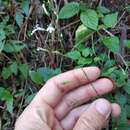Comprehensive Description
provided by North American Flora
Lobelia sartorii Vatke. Linnaea 38: 721. 1874
Lobelia novella B. L. Robinson, Proc. Am. Acad. 26: 167. 1891. (Pringle 328S, Gray!) Dortmannia Sartorii Kiintze, Rev. Gen. 973. 1891.
Lobelia piscinula F. E. Wimmer, Repert. Sp. Nov. 38; 84. 1935. (Lekmann 1379, isotype, US!). Lobelia calcarea F. E. Wimmer, Repert. Sp. Nov. 38: 83, in part. 1935.
Stem erect or ascending, sometimes decumbent, simple or with numerous ascending branches from the middle or below, 1-3 mm. in diameter at base, 10-85 cm. high, green, or (usually) purplish below (sometimes the whole plant purplish), usually glabrous above or slightly pubescent at base of branches, short-stiff -pubescent below or infrequently glabrous; leaves cauline, few-15 (40), often crowded in the lower third of the plant and appearing radical, all spreading-ascending and rather stiff when dry, short-stiff-pubescent with whitish hairs which collapse when dry, the pubescence sometimes wanting or essentially so, the margins varying from subentire, with minute callose teeth, to repand-denticulate or serrate, the blades lanceolate or narrowly elliptic, varying to broadly ovate or narrower, almost linear, or oval, the lowest ones broadest; petioles almost none or slender, up to 1-3 cm. long; principal leaves (0.2) 1-3.5 cm. wide by 2-5.5 (7) cm. long; inflorescence few-27 cm. long, often plainly secund, loosely few-27-flowered, appearing pedunculate, the stem naked below the lowest bract for a distance of 2-15 cm.; pedicels spreading-ascending, usually incurved in fruit, slender, 10-33 mm. long in fruit, glabrous or sparsely ciliate, each with a pair of minute bracteoles at base; flower-bracts linear-subulate, 2-6 mm. long or the lowest larger, glabrous or ciliate on the margins, entire or the lowest toothed; flower 8.5-13 mm. long, including hypanthium; corolla blue (?), glabrous without, the tube short-pubescent within and at base of lower lip (this sometimes glabrous), 4.0-5.5 mm. long, entire except for the dorsal fissure or sometimes fenestrate laterally, the lower lip somewhat reflexed, the lobes spreading, elliptic to obovate, 2-2.5 mm. wnde, 4-5 mm. long, the two upper lobes linear, erect, 3.5-4 mm. long; filamenttube 3-4 (5.5) mm. long, glabrous distally, the proximal half of the filaments free, pubescent or glabrous; anther-tube 1.0-1.8 mm. long, light bluish-gray, the two smaller anthers whitetufted at tip, the three larger ones ciliate on the backs; hypanthium in anthesis glabrous (rarely short bristly-pubescent), broadly obconic, in fruit becoming broadly turbinate or shortcampanulate, 2.5-3.5 mm. in diameter, as broad as high or nearly so; capsule one-half to twothirds inferior, 3.5-6 mm. long; calyx-lobes linear-subulate or narrowly triangular, glabrous or rarely pubescent, entire, 2-3 nun. long, usually purple-tipped in anthesis; seeds brown, ellipsoid, somewhat lustrous, about 0.6 mm. long, with faint longitudinal striae, these plainly visible with a magnification of 20 diameters.
Type LOC^Liri': Mexico (probably Vera Cruz), Sartorius (Field Mus. Neg. 9116!). Distribution: Southwestern Tamaulipas and eastern San Luis Potosi to northern Oaxaca, thence to Chiapas and central Guatemala, mostly at elevations of 1500-2500 m.
- bibliographic citation
- Rogers McVaugh. 1943. CAMPANULALES; CAMPANULACEAE; LOBELIOIDEAE. North American flora. vol 32A(1). New York Botanical Garden, New York, NY

